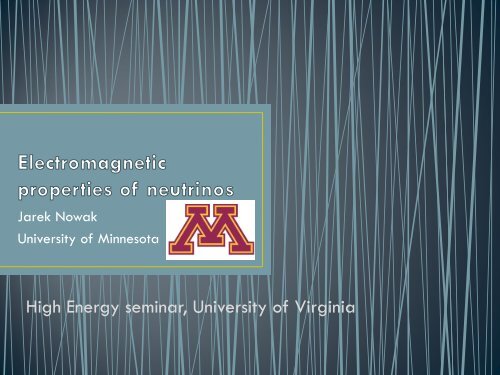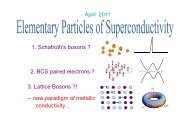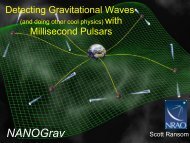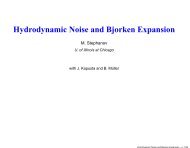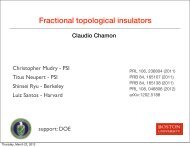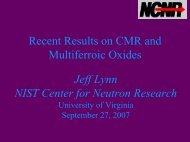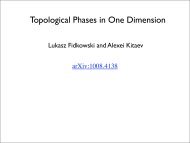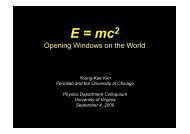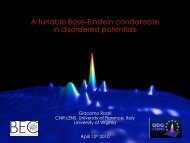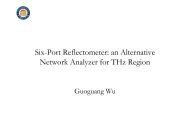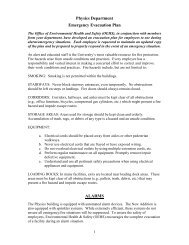Electromagnetic properties of neutrinos - University of Virginia
Electromagnetic properties of neutrinos - University of Virginia
Electromagnetic properties of neutrinos - University of Virginia
You also want an ePaper? Increase the reach of your titles
YUMPU automatically turns print PDFs into web optimized ePapers that Google loves.
Jarek Nowak<br />
<strong>University</strong> <strong>of</strong> Minnesota<br />
High Energy seminar, <strong>University</strong> <strong>of</strong> <strong>Virginia</strong>
• Properties <strong>of</strong> massive <strong>neutrinos</strong> in the Standard Model.<br />
• <strong>Electromagnetic</strong> <strong>properties</strong> <strong>of</strong> <strong>neutrinos</strong>.<br />
• Neutrino magnetic moment.<br />
• Results from neutrino experiments.<br />
• Constrains from astrophysical observations.<br />
I had to reschedule this seminar twice<br />
November: Stuck in Brazil<br />
March: Stuck in Minnesota<br />
2
• 2 body alpha decay, E <strong>of</strong> decay<br />
products always the same<br />
• 1913 - 1930 : beta decay =<br />
continuous spectrum <strong>of</strong> E<br />
• E not conserved?<br />
• P not conserved?<br />
• “I have done something very bad<br />
today by proposing a particle<br />
that cannot be detected; it is<br />
something no theorist should ever<br />
do.” (Pauli, 1930)<br />
3
• Wolfgang Pauli postulated existence <strong>of</strong><br />
neutrino (“little neutral ones”) in order to<br />
explain the missing energy in nuclear b -<br />
decay in 1930.<br />
• Enrico Fermi presented theory <strong>of</strong> beta<br />
decay in 1934.<br />
4
Neutrinos are massless<br />
Neutrinos only interact via the Weak force<br />
Neutrinos are left-handed (anti clock-wise)<br />
v<br />
spin<br />
anti-<strong>neutrinos</strong> are right-handed<br />
v<br />
‣ Force Carriers: Bosons<br />
‣ EM: Photon<br />
‣ Strong Force: Gluon (8)<br />
‣ Weak Forces: W + ,W - ,Z 0<br />
Neutrinos are electrically neutral<br />
Neutrinos have three flavors<br />
electron, muon, tau<br />
5
• Back in 1957, Pontecorvo pointed out that if n's have<br />
mass, then it could be the case that the mass<br />
eigenstates were not identical to the weak<br />
• Similar to kaon mixing where it was already known<br />
that the weak and strong (mass) eigenstates differed<br />
6
Given type <strong>of</strong> neutrino is<br />
always produced in one <strong>of</strong><br />
the charged leptons flavor<br />
e, µ and t.<br />
But they change their identity<br />
while traveling<br />
7
(For 3 n flavors mixing, it needs 3×3 unitary matrix with CP-violating phase.)<br />
Flavor eigenstates<br />
Mass eigenstates<br />
cos <br />
sin <br />
n 1<br />
n e<br />
=<br />
n <br />
-sin <br />
cos <br />
n 2<br />
|n (t)> = -sin |n 1 > + cos |n 2 ><br />
e -iE1t<br />
e -iE2t<br />
8
Neutrino flavor states are comprised<br />
<strong>of</strong> mass states<br />
m 1<br />
m 2<br />
n e<br />
n <br />
n <br />
ELECTRON<br />
n e<br />
9
m 2 is the difference <strong>of</strong> the<br />
squared masses <strong>of</strong> the two<br />
neutrino states (eV 2 )<br />
Distance from neutrino<br />
beam creation point to<br />
detection point (m,km)<br />
P osc =sin 2 2 sin 2 1.27 m 2 L<br />
is the mixing angle<br />
E<br />
E is the energy <strong>of</strong> the neutrino (MeV,GeV)<br />
10
• Solar : ~ 0.1 - 15 MeV (10 6 eV)<br />
• from fusion inside <strong>of</strong> stars<br />
• 85% from p+p -> 2 H + e + + n e<br />
• Man-Made : ~few MeV<br />
• Nuclear reactors - byproduct<br />
• Man-Made : ~ 0.5 MeV - 1 GeV (10 9 eV)<br />
• Accelerators - DAR, DIF<br />
• Atmospheric : ~1 - 10 GeV<br />
• cosmic rays = proton from outer space + atm =<br />
showers, creates atmospheric <strong>neutrinos</strong><br />
• Same as accelerator<br />
11
• Ray Davis set out to measure solar n's<br />
• Used a large vat <strong>of</strong> dry cleaning<br />
solution<br />
• Looking for inverse beta decay (CC)<br />
with Chlorine converting to Argon<br />
• Deep underground at Homestake gold<br />
mine to get away from cosmic ray<br />
background<br />
• First oscillation evidence came in 1968<br />
from Davis' solar n e experiment<br />
• found 1/3 <strong>of</strong> the expected n e from sun<br />
disappearance n e → n x<br />
• Δm 12<br />
2<br />
̴ 8x10 -5 eV 2 , sin 2 (2) ~ 0.8<br />
• Controversial result, do we understand<br />
fusion, is the experiment correct, could it<br />
be due to neutrino oscillation?<br />
12
U <br />
<br />
<br />
<br />
1 0 0<br />
0 cos 23<br />
sin 23<br />
0 - sin 23<br />
cos 23<br />
<br />
<br />
<br />
<br />
<br />
<br />
cos 13<br />
0 sin 13<br />
e -i<br />
0 1 0<br />
- sin 13<br />
e i 0 cos 13<br />
<br />
<br />
<br />
<br />
<br />
<br />
• (12) Sector: Reactor + Solar, L/E~15,000 km/GeV<br />
cos 12<br />
sin 12<br />
0<br />
- sin 12<br />
cos 12<br />
0<br />
0 0 1<br />
Still unknown<br />
<br />
<br />
<br />
<br />
<br />
† m 2 21<br />
7.50 0.19 -0.20<br />
10 -5 eV 2 tan 2 0.035<br />
12<br />
0.452 -0.033<br />
• (23) Sector: atmospheric and accelerator, L/E~500 km/GeV<br />
†† 2<br />
m 32<br />
2.32 0.12 -0.08<br />
10 -3 eV 2 * sin 2 (2 23<br />
) 0.96(90% C.L.)<br />
• (13) Sector mixing observed<br />
sin 2 2θ 13 = 0.098 ± 0.013<br />
†<br />
PRD 83.052002(2011)<br />
††<br />
PRL 106. 181801(2011)<br />
*<br />
SuperK Preliminary, Nu2010<br />
** 14<br />
Eur.Phys. C27:331-374,2003
• Neutrinos are not massless, but their mass is very<br />
small.<br />
• If <strong>neutrinos</strong> have mass they travel with v < c<br />
v<br />
v<br />
left-handed n<br />
Boost V>v<br />
right-handed n<br />
• Neutrinos as neutral fermions can be Dirac or<br />
Majorana particles.<br />
• Dirac <strong>neutrinos</strong>: particle and antiparticle are different<br />
• Majorana <strong>neutrinos</strong> are the same particle as<br />
anti<strong>neutrinos</strong>.<br />
15
• Neutrino electromagnetic <strong>properties</strong> can be used to distinguish<br />
Dirac and Majorana <strong>neutrinos</strong><br />
• Probes <strong>of</strong> new physics that might exist beyond the Standard<br />
Model<br />
17
• Neutrino electromagnetic <strong>properties</strong> can be used to distinguish<br />
Dirac and Majorana <strong>neutrinos</strong><br />
• Probes <strong>of</strong> new physics that might exist beyond the Standard<br />
Model<br />
Because neutrino electric<br />
charge is zero<br />
18
• Neutrino electromagnetic <strong>properties</strong> can be used to distinguish<br />
Dirac and Majorana <strong>neutrinos</strong><br />
• Probes <strong>of</strong> new physics that might exist beyond the Standard<br />
Model<br />
Because neutrino electric<br />
charge is zero<br />
Neutrino interaction due to EM moments<br />
can occur at the loop level.<br />
Helicity flip (left-handed to right-handed)<br />
19
• For Dirac <strong>neutrinos</strong><br />
• For small a l
• In the extended Standard Model with right-handed <strong>neutrinos</strong><br />
• The diagonal dipole electric moment for Dirac <strong>neutrinos</strong> vanishes<br />
• For the Majorana <strong>neutrinos</strong> both electric and magnetic diagonal<br />
moments vanish (matrix is anti-symmetric, CPT invariance)<br />
21
• Neutrino transition moments are <strong>of</strong>f-diagonal element <strong>of</strong><br />
• First non-vanishing elements come from the second term in<br />
expansion <strong>of</strong> f(al) with<br />
• The transition moments are suppressed wrt diagonal moments<br />
22
• For Majorana <strong>neutrinos</strong> the transition moments may be nonvanishing.<br />
• Assuming CP conservation, if<br />
have the same CP phase<br />
• And when<br />
have opposite CP phase<br />
• Those moments are still suppressed wrt. diagonal moments.<br />
23
• Magnetic moment that is measured in experiment is not that <strong>of</strong><br />
a massive neutrino, but it is an effective magnetic moment which<br />
takes into account neutrino mixing during the propagation<br />
between source and detector<br />
• Only for the magnetic moment<br />
• And in the case <strong>of</strong> Dirac neutrino with only diagonal moment it<br />
simplifies to<br />
24
• If the neutrino magnetic moment is greater than<br />
it implies non-trivial extension to the Standard Model<br />
• There are many different models with high value <strong>of</strong> the<br />
magnetic moments but as an example<br />
• SUSY models<br />
• μ νe ≅ 10 −15 − 10 −16 μ B<br />
• μ νμ ≅ 10 −12 − 10 −13 μ B<br />
• μ ντ ≅ 10 −12 μ B<br />
• Neutrino magnetic moment not in all models is proportional to<br />
neutrino mass.<br />
25
• The most widely used method to determine neutrino magnetic<br />
moment is a process<br />
26
• Cross sections are added incoherently<br />
• Two observables<br />
• Scattering angle<br />
• Kinetic energy <strong>of</strong> recoil electron<br />
27
• Direct measurement <strong>of</strong> <strong>neutrinos</strong><br />
• Solar <strong>neutrinos</strong><br />
• Reactor anti-<strong>neutrinos</strong><br />
• Accelerator base <strong>neutrinos</strong><br />
• SN1987A<br />
• Astronomical observations<br />
• Evolution <strong>of</strong> Red Giants (He ignition)<br />
• Cosmic background<br />
28
• All reactor experiments measure the neutrino magnetic moment<br />
by looking at deviation <strong>of</strong> the recoil electron spectrum from SM<br />
prediction for elastic neutrino-electron scattering.<br />
• Savannah River Laboratory (1976, analysis in 1989)<br />
• Krasnoyarsk experiment (1992) `<br />
• Rovno experiment (1993)<br />
• TOXONO experiment (2007)<br />
• GEMMA experiment (2012)<br />
29
• The limit <strong>of</strong> the muon-neutrino<br />
was obtained in the LSND using<br />
decay.<br />
fluxes from p + an +<br />
30
• The first and only limit <strong>of</strong> the<br />
tau-neutrino magnetic<br />
moment was set by the<br />
DONUT experiment.<br />
• 1 event was observed with<br />
2.3 predicted background.<br />
31
• The best results for solar <strong>neutrinos</strong> were obtained by the<br />
BOREXINO collaboration.<br />
• The new upper limit for μ ν from pp and 7 Be solar <strong>neutrinos</strong>.<br />
Type equation here.<br />
(1) the spectrum <strong>of</strong> recoil<br />
electrons due to magnetic<br />
scattering;<br />
(2) 14C β spectrum;<br />
(3) linear background;<br />
(4) total fit.<br />
32
• Prior to the helium ash, the degenerate<br />
He core radiates energy largely by<br />
neutrino pair emission.<br />
• Plasmons couple to an electron-hole pair<br />
an decays to Z 0 → νv .<br />
• The neutrino magnetic moment would<br />
enhance cooling and will leave the star<br />
with bigger He core (and alter its<br />
evolution).<br />
• Looking at the ratio <strong>of</strong> red giants to<br />
horizontal branch the unacceptable<br />
modification will be caused by<br />
μ ij ≤ 3 × 10 −12 μ B<br />
PhysRevD.37.549<br />
33
• If neutrino has a nonzero magnetic moment,<br />
then the scattering due to the photon<br />
exchange between a neutrino and a charged<br />
particle in plasma leads to the neutrino spin<br />
flip.<br />
• If a produced particle is a right-handed<br />
neutrino ( sterile ), it leaves SN without further<br />
interactions.<br />
• This pattern contradicts to the observed<br />
neutrino signal <strong>of</strong> SN 1987A. The energy<br />
released in SN implosion is taken away by<br />
sterile <strong>neutrinos</strong>. Due to this no energy is left<br />
for the envelope explosion.<br />
34
• A neutrino mass eigenstate may<br />
decay to another one by the emission<br />
<strong>of</strong> a photon, where the only<br />
contributing form factors are the<br />
magnetic and electric transition<br />
moments.<br />
35
810 km<br />
• Use the upgraded NuMI beam at<br />
Fermilab.<br />
• Construct a totally active liquid<br />
scintillator detector <strong>of</strong>f the main<br />
axis <strong>of</strong> the beam.<br />
• Far detector is 14 mrad <strong>of</strong>f- axis<br />
and on the surface (14kton).<br />
• Near detector is also 14 mrad <strong>of</strong>faxis<br />
but underground(330ton).<br />
• Location reduces background.<br />
• If <strong>neutrinos</strong> oscillate, electron<br />
<strong>neutrinos</strong> are observed at the Far<br />
Detector in Ash River, 810 km<br />
away.<br />
36
FD<br />
ND<br />
p +<br />
Target<br />
π +<br />
Decay Pipe<br />
ν<br />
θ<br />
E p<br />
E n<br />
0.43<br />
1 2 2<br />
n<br />
At 14 mrad <strong>of</strong>f-axis, narrow band<br />
beam peaked at 2 GeV<br />
Near oscillation maximum<br />
Few high energy NC background events<br />
37
Events<br />
Neutrino mode<br />
Horns focus π + , K +<br />
νμ<br />
_<br />
νμ<br />
Target<br />
Focusing Horns<br />
π -<br />
2 m<br />
ν μ<br />
120<br />
GeV p’s<br />
from MI<br />
π +<br />
ν μ<br />
15 m 30 m<br />
675 m<br />
38
Events<br />
Neutrino mode<br />
Horns focus π + , K +<br />
Anti-neutrino Mode<br />
Horns focus π - , K -<br />
enhancing the ν μ flux<br />
νμ<br />
_<br />
νμ<br />
_<br />
νμ< 2%<br />
νμ ~ 10%<br />
Target<br />
Focusing Horns<br />
120<br />
GeV p’s<br />
from MI<br />
π - π +<br />
2 m<br />
ν μ<br />
ν μ<br />
15 m 30 m<br />
675 m<br />
39
• 14 kton Far Detector<br />
• 64 % active detector.<br />
• 344,064 detector cells read by APDs.<br />
• 0.3 kton Near Detector<br />
• 19,104 cells (channels).<br />
32‐pixel<br />
APD<br />
• Each plane just 0.15 X 0 . Great for e - vs. π 0 .<br />
Both ends <strong>of</strong> a<br />
fiber to one pixel<br />
Far detector<br />
14 kton<br />
986 planes<br />
Near detector<br />
0.3 kton<br />
Prototype detector<br />
0.2 kton<br />
40
Excellent granularity for a detector<br />
<strong>of</strong> this scale<br />
X 0 = 38 cm (6 cell depths, 10 cell widths)<br />
γ<br />
41
• The upgraded NuMI beam will provide with very intense beam<br />
<strong>of</strong> ν μ and v μ.<br />
• The cross section for the elastic ν μ + e → ν μ + e is expressed in<br />
term <strong>of</strong> the recoil energy <strong>of</strong> the outgoing electron.<br />
• Signal signature in the NOvA near detector<br />
• Only e produces low energy electron with significant cos variations for<br />
cos > 0.90.<br />
• The kinetic energy cut: 15MeV < T < 100MeV.<br />
• 15MeV < T: - capture produce boron nuclei which beta decay 12 B 12 C<br />
with energy endpoint 13.4 MeV.<br />
• For T > 100MeV the weak interaction dominates @LSND limit.<br />
43
• With our best reconstruction algorithms at this moment we<br />
expect about 150 reconstructed events <strong>of</strong> ν μ + e → νμ + e<br />
with true T e
• <strong>Electromagnetic</strong> <strong>properties</strong> are still unknown.<br />
• Limits on magnetic moments from astrophysical sources are<br />
lower by a few orders <strong>of</strong> magnitude that from terrestrial<br />
experiments.<br />
• The new neutrino experiments can set new limits due to their<br />
high intensity ( assuming background can be removed).<br />
45


